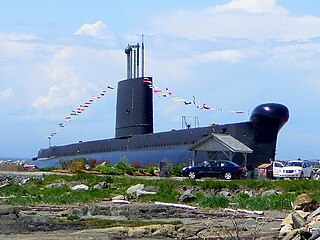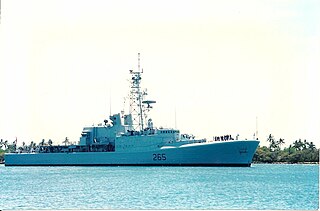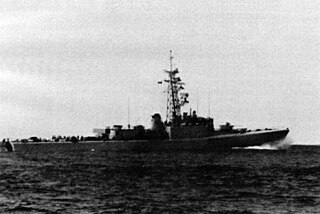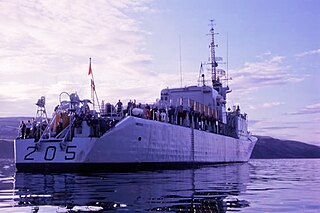
Iroquois-class destroyers were a class of four helicopter-carrying, guided missile destroyers of the Royal Canadian Navy. The ships were named to honour the First Nations of Canada.

HMCS Onondaga (S73) is an Oberon-class submarine that served in the Royal Canadian Navy and later the Canadian Forces. Built in the mid-1960s, Onondaga operated primarily with the Maritime Forces Atlantic until her decommissioning in 2000 as the last Canadian Oberon.

HMCS Okanagan (S74) was an Oberon-class submarine that served in the Canadian Forces (CF). She entered service in 1968 and spent the majority of her career on the east coast. The ship was paid off in 1998 and sold for scrap in 2011.

HMCS Ojibwa is an Oberon-class submarine that served in the Royal Canadian Navy (RCN) and later the Canadian Forces Maritime Command (MARCOM). Originally intended for service with the British Royal Navy as HMS Onyx, the submarine was transferred to Canadian ownership before completion, and entered RCN service in 1965. Ojibwa operated primarily with Maritime Forces Atlantic until her decommissioning in 1998. In 2010, Ojibwa was laid up at CFB Halifax awaiting disposal, with the Elgin Military Museum planning to preserve her as a museum vessel. The submarine was towed to Port Burwell, Ontario in 2012, and was opened to the public in 2013. She is now the new focal point of a planned Museum of Naval History to be built alongside.

HMCS Yukon was a Mackenzie-class destroyer that served in the Royal Canadian Navy (RCN) and later the Canadian Forces. She was the first Canadian naval unit to carry the name. She was named for the Yukon River that runs from British Columbia through Yukon and into Alaska in the United States.

HMCS Nipigon was an Annapolis-class destroyer that served in the Royal Canadian Navy and later the Canadian Forces. She was the second Canadian naval unit to carry this name. Entering service in 1964, she was named for the Nipigon River that flows through Ontario.

HMCS Annapolis was an Annapolis-class destroyer that served in the Royal Canadian Navy and later, the Canadian Forces. She was the second Canadian naval unit to carry this name. Named for the Annapolis River that flows through Nova Scotia, the ship entered service in 1964, the last of the St. Laurent-class design. Serving through the Cold War, Annapolis was decommissioned in 1998 before going through a protracted legal battle for use as an artificial reef. She was finally scuttled as such in April 2015 in Howe Sound, British Columbia.

The Claud Jones-class destroyer escorts were four destroyer escorts built for the United States Navy in the late 1950s. These ships were a diesel-powered version of the earlier Dealey class and were designed with the aim of producing a cheaper ship suitable for rapid production in wartime. These ships also had reduced armament and speed compared to their predecessors. They were not seen as effective anti-submarine warfare vessels by the United States Navy and were sold after only 15 years service to the Indonesian Navy.

The Cheng Kung-class frigates are eight guided-missile frigates in service in the Republic of China Navy (ROCN). They are based upon the U.S. Oliver Hazard Perry class and built by China Shipbuilding Corporation in Kaohsiung, Taiwan under license throughout the 1990s as part of the Kuang Hua I project. These frigates served as the mainstay of the ROCN's area air defense capability prior to the acquisition of the Keelung (Kidd)-class destroyers in 2005. They are designated with the hull classification PFG rather than FFG used by the Oliver Hazard Perry class.

HMCS Mackenzie was a Mackenzie-class destroyer that served in the Royal Canadian Navy (RCN) and later the Canadian Forces. She was the lead ship of her class and is the first Canadian naval unit to carry this name. The ship was named for the Mackenzie River, the largest river system in Canada and runs primarily through the Northwest Territories.

HMCS Qu'Appelle was a Mackenzie-class destroyer that served in the Royal Canadian Navy and later the Canadian Forces. The ship's insignia and logo was the head of a fox facing forward centered in a diagonal line double white with a red center sqiggley line from the top left to bottom right. The moniker of the ship was "Follow the Fox".

HMCS Restigouche was the lead ship of the Restigouche-class destroyers that served in the Royal Canadian Navy and later the Canadian Forces. Commissioned in 1958, Restigouche remained in service until 1994. She was sold for use as an artificial reef, however controversy arose over her acquisition and instead she was scuttled off the coast of Mexico in 2001. She was the second Canadian warship to carry the name HMCS Restigouche.

The Restigouche-class destroyer was a class of seven destroyer escorts that served the Royal Canadian Navy and later the Canadian Forces from the late-1950s to the late-1990s. All seven vessels in the class were named after rivers in Canada.

HMCS Skeena was a St. Laurent-class destroyer that served in the Royal Canadian Navy and later the Canadian Forces from 1957 to 1993. Skeena was constructed as a destroyer escort and was converted in the 1960s to a helicopter-carrying destroyer. In 1972, the ship was designated a French Language Unit, the second in Canadian service. Discarded in 1994, the ship was broken up in India.
HMCS Ottawa was a St. Laurent-class destroyer that served in the Royal Canadian Navy and later the Canadian Forces from 1956 to 1992. Ottawa was the first bilingual ship to serve in the Canadian navy.

The Mackenzie-class destroyer was a class of warship used by the Royal Canadian Navy and Canadian Forces from the 1960s–1990s. Six such ships were envisioned, of which four were completed to this specification. The last two hulls were completed to the post DDH conversion St. Laurent-class design ; they were designated as the Annapolis class instead. The four Mackenzie-class destroyers spent most of their service in the Pacific Ocean, used primarily in a training role. Their only significant update was the DELEX program, which was completed between 1982 and 1985 and updated their navigational radar and their sonar.

HMCS Saskatchewan was a Mackenzie-class destroyer that served in the Royal Canadian Navy (RCN) and later the Canadian Forces. She was the second Canadian naval unit to bear the name HMCS Saskatchewan. The ship was named for the Saskatchewan River which runs from Saskatchewan to Manitoba in Canada.

The Annapolis-class destroyer escort was a two-ship class of destroyer escorts that saw service with the Royal Canadian Navy and Canadian Forces from the 1960s to the 1990s. The final version of the St. Laurent-class design, the class was used extensively for anti-submarine warfare purposes. Both ships were sunk as artificial reefs after being retired, one on each coast of Canada.

HMCS St. Laurent was a St. Laurent-class destroyer that served in the Royal Canadian Navy and later the Canadian Forces from 1955–1974. She was the lead ship of her class, the first modern warship designed and built in Canada.

The Canadian Patrol Frigate Project (CPFP) was a procurement project undertaken by the Department of National Defence of Canada beginning in 1975 to find a replacement for the 20 combined ships of the Annapolis, Mackenzie, Restigouche, and St. Laurent classes of destroyer escorts. The CPFP was considered a core effort in the fleet modernization of Canada in the 1980s. Facing several contract hurdles, the construction program got underway in 1987. The CPFP became known as the Halifax-class frigate upon the construction of the ships. The Halifax class replaced the destroyer escort classes in the 1990s and remains a core element of the fleet.


















